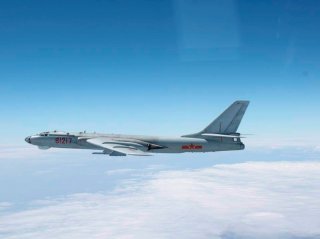China's Hypersonic Missile Bombers are a Real Threat to the United States
It appears that China does want a bomber-launched hypersonic missile. This would be similar to U.S. efforts with the ARRW missile for the B-52.
Key point: A nuclear-armed hypersonic missile might present alarming first-strike possibilities for an adversary such as China which could use air-leveraged positioning to hold large areas at risk quickly.
A newly emerged image of a Chinese H-6N bomber (see above, from Weibo) appears to show what looks like a hypersonic missile mounted beneath the fuselage, raising new questions about what kind of threat it may present.
The photograph shows an elongated missile aligned in a parallel fashion beneath the side of the aircraft, revealing what an article in The Drive says could be a hypersonic boost-glide vehicle similar to that which sits on top of the Chinese DF-17 missile.
An air-fired boost-glide hypersonic weapon would change the tactical threat envelope presented by China in several key respects, as it could bring new dimensions of mobility to attack options. Not only does the speed of hypersonic weapons make them very difficult to track, but an air-moving launch would complicate efforts to identify a point of origin for the attack.
If a heat signature of the attack can be detected from any kind of a fixed location, a radar track can be identified more quickly. However, given the speed at which a hypersonic missile could transit from one radar field of view to another, making its flight trajectory and intended target difficult for various defenses to discern.
Further, a nuclear-armed hypersonic missile might present alarming first-strike possibilities for an adversary such as China which could use air-leveraged positioning to hold large areas at risk quickly.
When it comes to the prospect of tracking or defending a weapon of this kind, of course, should it be mature enough to present a serious near-term threat, it would seem to rely greatly upon the sophistication of space-based sensors. Boost glide vehicles would typically skim along the upper boundary of the earth’s atmosphere, using the speed of descent to inflict a massive, destructive kinetic energy collision upon impact.
Detection, therefore, would hinge greatly upon the ability of satellite-based sensors and ground-based radar to quickly coordinate track loop data and pass flight path information from one envelope or field of view to another to generate a continuous or “seamless” track upon the threat.
There are other kinds of emerging defenses against hypersonic weapons to include the possibility of laser interceptors or newer kinds of technologies designed to disrupt the airflow, and therefore the flight path, of an approaching hypersonic weapon. Traveling at the speed of light, laser weapons might be one of the few weapons fast enough to take out a hypersonic projectile.
The more effectively a weapon moving at that speed can be tracked, the better the prospect of launching some kind of interceptor weapon to knock out or destroy the attacking missile. The prospect of this kind of defensive posture raises interesting questions about the kinds of interceptors which might be fast and accurate enough to succeed in stopping or derailing the hypersonic weapon. This could mean a need to create some kind of hypersonic-to-hypersonic air collision, as perhaps only something traveling at comparable speeds might be able to succeed in stopping a hypersonic missile.
Much like a space-operating kill vehicle such as those now built into Ground-Based Interceptors for missile defense, a hypersonic interceptor would need to have some kind of seeker or sensor to discriminate an actual hypersonic attack. However, perhaps it could be guided by various kinds of satellite-mounted sensors that would have to operate with an ability to track the heat signature and flight trajectory of a hypersonic vehicle while in flight and not just at a launch point. An advanced interceptor would not only have to have the requisite, precision-capable sensors but also be able to travel fast enough to achieve an actual intercept or kill against a hypersonic weapon moving at five times the speed of sound.
Kris Osborn is defense editor for the National Interest. Osborn previously served at the Pentagon as a Highly Qualified Expert with the Office of the Assistant Secretary of the Army—Acquisition, Logistics & Technology. Osborn has also worked as an anchor and on-air military specialist at national TV networks. He has appeared as a guest military expert on Fox News, MSNBC, The Military Channel, and The History Channel. He also has a Masters Degree in Comparative Literature from Columbia University. This first appeared earlier and is being reposted due to reader interest.
Image: Reuters.

